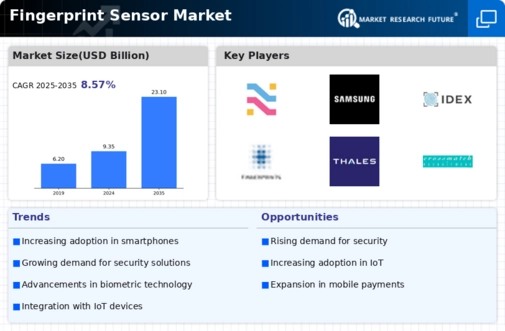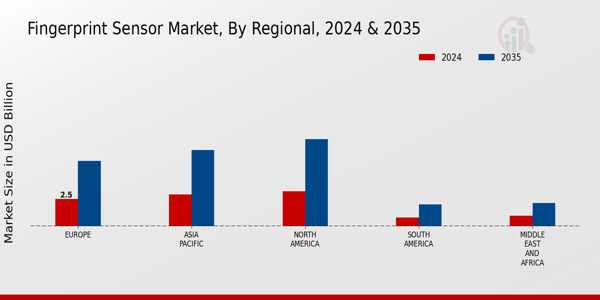Market Growth Projections
The Global Fingerprint Sensor Market Industry is poised for substantial growth, with projections indicating a market value of 9.35 USD Billion in 2024 and an anticipated increase to 23.1 USD Billion by 2035. This growth trajectory suggests a compound annual growth rate (CAGR) of 8.57% from 2025 to 2035. The expansion is driven by various factors, including technological advancements, increasing adoption in consumer electronics, and rising demand for biometric security solutions. As industries continue to prioritize security and efficiency, the fingerprint sensor market is likely to evolve, presenting opportunities for innovation and development across multiple sectors.
Government Initiatives and Regulations
Government initiatives and regulations significantly influence the Global Fingerprint Sensor Market Industry. Many governments are implementing policies that promote the use of biometric systems for identification and access control in public services, law enforcement, and border security. These initiatives aim to enhance national security and streamline processes, thereby increasing the demand for fingerprint sensors. For instance, various countries are investing in biometric databases and infrastructure to support these initiatives. As a result, the market is expected to expand, driven by the need for secure and efficient identification methods in government operations, further solidifying the role of fingerprint sensors in public safety.
Increasing Adoption in Consumer Electronics
The Global Fingerprint Sensor Market Industry is witnessing a substantial increase in the adoption of fingerprint sensors in consumer electronics. Smartphones, tablets, and laptops are increasingly incorporating biometric authentication features, driven by consumer demand for enhanced security and convenience. This trend is particularly evident in the smartphone market, where fingerprint sensors have become a standard feature in many flagship devices. The growing awareness of data privacy and security concerns among consumers further fuels this adoption. As the market evolves, it is anticipated that the compound annual growth rate (CAGR) for the period from 2025 to 2035 will reach 8.57%, indicating a robust growth trajectory for fingerprint sensors in consumer electronics.
Growth of E-commerce and Digital Transactions
The Global Fingerprint Sensor Market Industry is significantly influenced by the growth of e-commerce and digital transactions. As online shopping and digital payment methods become increasingly prevalent, there is a heightened need for secure authentication methods to protect consumer data and prevent fraud. Fingerprint sensors offer a reliable solution for verifying identities during online transactions, thereby enhancing consumer trust and security. This trend is expected to contribute to the market's expansion, with a projected value of 23.1 USD Billion by 2035. The integration of fingerprint technology in payment systems and e-commerce platforms is likely to drive further adoption, reflecting the evolving landscape of digital commerce.
Rising Demand for Biometric Security Solutions
The Global Fingerprint Sensor Market Industry experiences a notable surge in demand for biometric security solutions across various sectors. Organizations are increasingly adopting fingerprint sensors to enhance security measures, particularly in banking, healthcare, and government applications. This trend is driven by the need to protect sensitive information and prevent unauthorized access. As of 2024, the market is valued at approximately 9.35 USD Billion, reflecting a growing recognition of the importance of biometric authentication. The integration of fingerprint sensors into mobile devices and access control systems further propels this demand, indicating a shift towards more secure and user-friendly authentication methods.
Technological Advancements in Sensor Technology
Technological advancements play a pivotal role in shaping the Global Fingerprint Sensor Market Industry. Innovations in sensor technology, such as capacitive and optical sensors, enhance the accuracy and efficiency of fingerprint recognition systems. These advancements facilitate the development of compact and cost-effective solutions, making fingerprint sensors more accessible to a broader range of applications. The continuous evolution of algorithms and processing capabilities further improves the performance of these sensors. As a result, the market is projected to grow significantly, with an estimated value of 23.1 USD Billion by 2035, showcasing the potential for further integration of fingerprint technology in various devices.























Leave a Comment